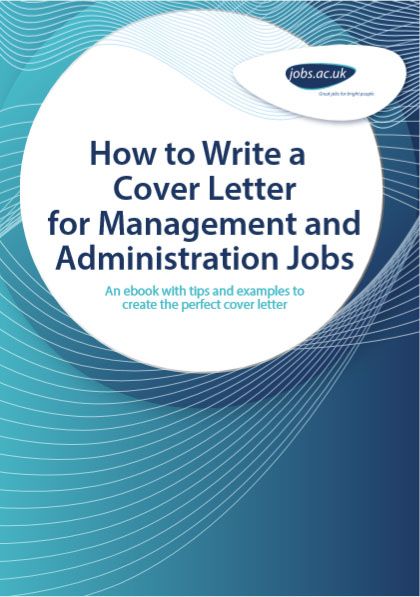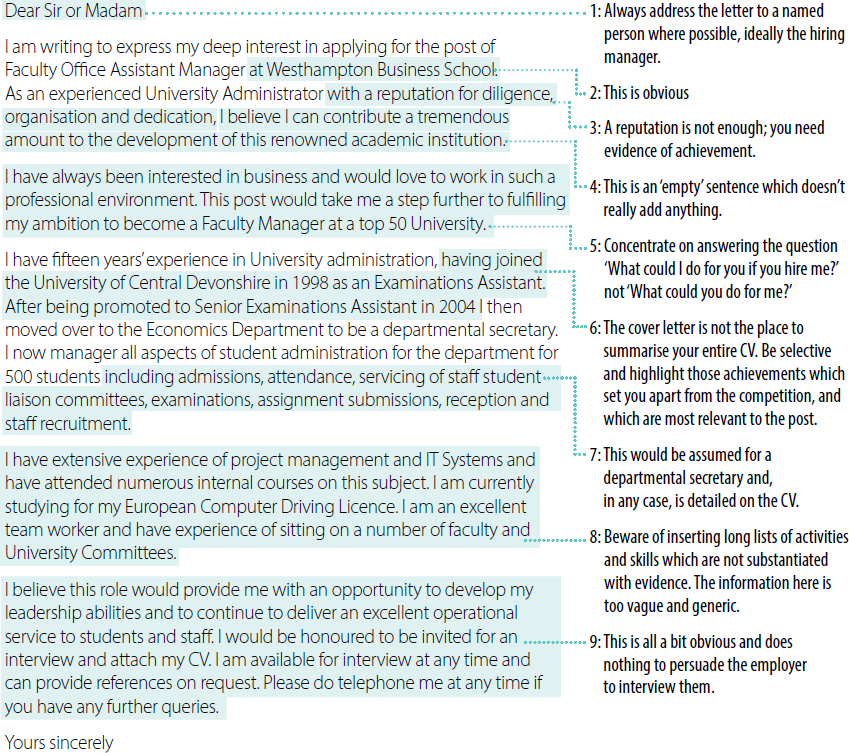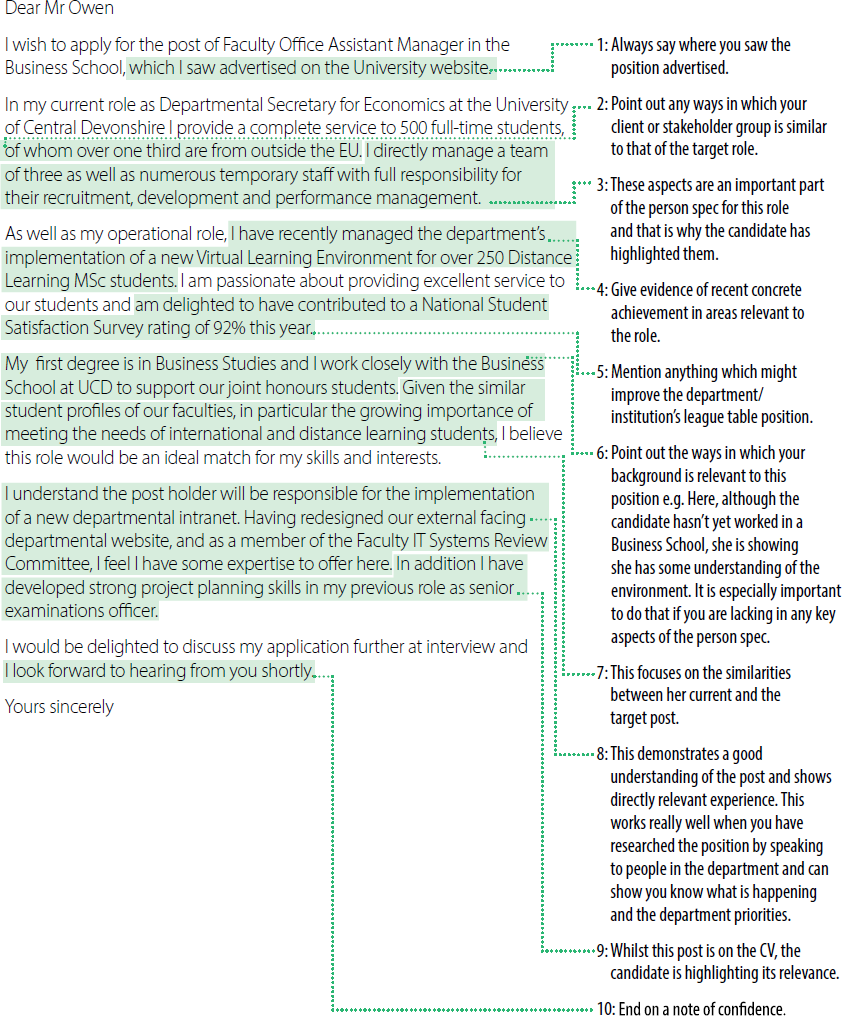The purpose of your cover letter
The power of the cover letter in making an effective job application should never be underestimated. A good cover letter will grab the employer’s attention and make them want to read your CV. The purpose of your cover letter and CV together is to whet the employer’s appetite, to establish you as a serious contender for the post and to persuade the recruiter that you are worth an interview.
The cover letter exists to:
- Demonstrate your enthusiasm for the post, based on the research you have done about the role and the institution
- Explain your rationale for applying and how the role fits with your career plans
- Answer the question “Why should we hire you?” by demonstrating how you meet the key criteria for the post and what sets you apart from other candidates
- Provide evidence of your written communication and language skills, including the ability to be clear, succinct and articulate.
This article focuses on cover letters for roles in HE Management and Administration and addresses:
- When to send a cover letter
- What format to use
- How to tailor it to a particular role
- Marketing yourself in the cover letter
- The dos and don’ts of cover letter writing
- An example ‘before’ and ‘after’ cover letter with detailed explanations of the improvements made
- A checklist for you to ensure your cover letter is as effective as possible.
When to send a cover letter
You should always send a cover letter with your CV unless you are expressly asked not to. The only exception is if you are posting your CV on a database/with an agency where it will be seen by numerous employers, in which case a Profile on the CV itself is helpful.
Even if you have explained your motivation for applying on the application form, it is still worth sending a separate cover letter. This is because the cover letter gives you another opportunity to market yourself and can strengthen your chances.
The format of a cover letter
For jobs in administration and management, you should aim for your letter to be no longer than three-quarters of a page. In order to make an impact, and to prove that you can explain ideas fluently and clearly, the letter needs to be succinct.
Keep paragraphs short and your typeface clear (a font size of 11 or 12 is recommended) as the employer’s attention span will be brief.
It is traditional to write the cover letter in paragraph format, and this is the format we have used for our example letter, although some candidates choose to use bullet points and/or bold to highlight key points.
The order of paragraphs is not critical, but the following structure is recommended:
- Address and salutation: Address the letter to a named person i.e. the recruiting manager who will shortlist the applications. A quick phone call or email should elicit this information.
- First paragraph: An introduction, explaining which job you are applying for, how you heard about the post, and some brief background on who you are e.g. in terms of your current job role.
- Middle section: Evidence of how you meet the top 3 or 4 criteria for the role, with brief illustrations of your achievements in each.
- Final section: Explain what attracts you to this role in this institution and how the role fits into your career plans.
- Concluding paragraph: A conclusion summarising what makes you suitable for the job and a statement expressing interest in an interview.
Tailoring your letter
The best way to tailor your letter effectively is to:
Do your research
Your cover letter needs to show what a great match you are for the job. The job and person specification will only give you so much. In order to understand the job context, the key priorities, what the recruiters are really looking for and how the job might develop you need do your own research.
This could include:
Online research
For example: into the University and Department’s strategies and future plans, it’s student profile, organisational structure and so on. For external appointments, you may be limited to what is available publicly so do use your networks to access these. You may be able to find useful information on news sites and publications such as the Research Assessment Exercise and Good University guides.
Discussion with the recruiting manager
Most recruiters are only too happy to answer questions about the job from potential applicants beforehand. This can also help you get your ‘name in the frame’ early. Just ensure that your questions are intelligent and be warned that the conversation might turn into an informal interview. You should reflect on why the employer should hire you, and refine your ‘elevator pitch’ before arranging the call.
Conversations with other employees
Including the departing jobholder, their colleagues and subordinates. For internal roles, you can use your internal networks to find these people. For external roles, you might ask the recruiting manager to put you in touch – or use your networks to see who knows someone in the right department and institution.
The depth of your research will show in your application and can really distinguish serious applicants from the rest of the pack. It’s also great preparation for the interview stage.
Be selective
The best way to tailor your letter is to pick out only the top three or four criteria for the post and focus your evidence on these. If the employer is convinced you have the right credentials, experience and skills for the areas that matter most, the chances are that they will invite you to interview. Your CV and your interview can cover the rest.
Use the employer’s language
Ensure you use the same keywords in your letter as the employer uses in their advertisement and in other sources (such as the Institution’s Values or Strategy statement). Listen carefully in conversations with the recruiter and colleagues for any buzzwords. If the institution talks about ‘student engagement’, ‘research capability’, ‘lean management’ or ‘employability’ issues – it will help if you talk about your experience and interests in the same terms.
Marketing yourself effectively
Before you write your letter, you need to be clear on what your Unique Selling Points are for the role in relation to the key job criteria.
Think about what will differentiate you from the competition. Consider who else might apply, internally and externally, and what they might offer. Consider what makes you stand out from them. This might include:
- Greater depth of expertise or length of experience in this field
- A particular blend of experiences which give you a unique perspective (e.g. having worked in both central functions and academic departments, or having been a student yourself recently for student-facing posts)
- Specific achievements in your current and previous roles
- A qualification which is highly relevant to the role, but which not all the other applicants will have
- A passion for and commitment to the subject matter of the job or for working in this particular area
- Well developed professional networks in a relevant field which could prove helpful in the job
- Or anything else you think might make the stand out in a way which is relevant to the role.
Tips for success
Do:
- Put your most convincing evidence first. You need to make an impact in the first few sentences. Talk about your current or most relevant job first
- Focus on achievements in your current and previous roles rather than merely your responsibilities. Quantify these wherever possible
- Illustrate your achievements with brief but specific examples, explaining why these are relevant to this role. You can refer the employer to the CV for more detail
- Concentrate on the areas which differentiate you from the competition rather than the basic job criteria
- Demonstrate how well you have researched the role and the job context when explaining your career motivation
- Explain your rationale if you are seeking a career change or sideways move
- Be succinct. Ask a friend to go through it with you and edit out any wordy sentences and redundant words
- End on a note of enthusiasm and anticipation.
Don’t:
- Try to summarise your CV or give too much detail – you need to be selective about the points that you highlight
- Make unsubstantiated statements about relevant skills and experience without giving examples
- Send the same or a similar letter to more than one employer. Never ‘cut and paste’ as employers will suspect a lack of research and career focus
- Make generalised statements about why you want to work for the institution (e.g. referring to ‘a top 50 global institution’ or ‘a department with a high reputation’)
- Use jargon specific to your employer or profession which the employer might not understand
- Focus on what the employer can do for you – it’s more about what you can do for the employer.
Example cover letter – with comments
Example cover letter – improved version
Cover letter checklist
Before you send off your letter, use our final checklist to ensure your letter is as strong as possible.
Have you:
- Done your homework so that you are clear about what the employer wants?
- Given clear evidence of how you meet the most important criteria of the job?
- Kept it to three quarters of a page or less?
- Put your most important evidence in the first half of the letter?
- Asked a friend to proof read it and ensure the language is succinct and clear?
- Addressed it to the right person?
- Given a convincing explanation of why you want the job?
- Ended with a summary of why you would be perfect for this role?
Download the ‘How to Write a Cover Letter for Management and Administration Jobs’ ebook here.
You may also like:
To help with your career progression and achieving your career goals, this 37-page interactive electronic guide on Continuing Professional Development (CPD) will give you a structured and step-by-step approach to your professional development.




Leave a Reply